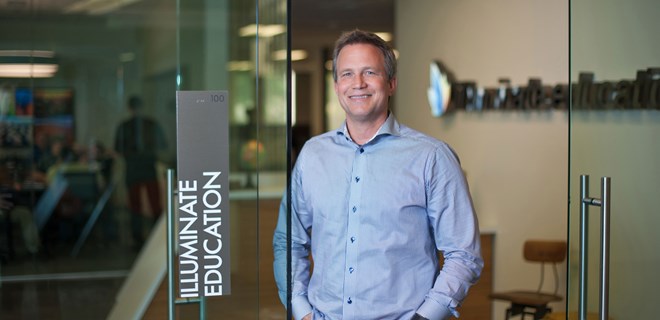Online Education
Thought Leaders in Online Education: Executive Director of Academic Innovation at University of Pennsylvania, Bobbi Kurshnan (Part 2)
Sramana Mitra: How much equity do you take against the $20,000 initial funding?
Bobbi Kurshnan: Between 6% to 8%.
Sramana Mitra: That’s expensive.
Bobbi Kurshnan: Yes, but these are early companies.
Sramana Mitra: In my program, I advise people against going for these kinds of incubators that take 6%to 8%. I think it’s a terrible model. We disagree on that and let’s move on. What are you seeing in terms of monetization trends in the kinds of businesses that you are involved with? >>>
Thought Leaders in Online Education: Executive Director of Academic Innovation at University of Pennsylvania, Bobbi Kurshnan (Part 1)
UPenn has both an incubator for EdTech ventures, and an entrepreneurship education program for EdTech. This discussion delves into both programs and more.
Sramana Mitra: Let’s start by introducing our audience to yourself as well as to UPenn’s online education activities.
Bobbi Kurshnan: I am the Executive Director of Academic Innovation at the University of Pennsylvania Graduate School of Education. I run a variety of programs including all our online initiatives. I also run our incubator program for educational startups. That is both virtual as well as in-person. We just concluded our fourth and fifth cohorts this week. We also run the largest business competition for education entrepreneurs. >>>
Building Multiple Bootstrapped Education Software Companies: Lane Rankin, CEO of Illuminate Education (Part 1)
Lane was first a teacher, then a school and school district administrator. His background is not of a typical tech entrepreneur. However, his deep domain knowledge and relationships in the education field have propelled him to become a very successful EdTech entrepreneur. Great story!
Sramana Mitra: Let’s start at the very beginning of your entrepreneurial journey. Where are you from? Where were you born, raised, and in what kind of background?
Lane Rankin: I’m currently in California. I was born in Seattle, Washington. I have a Bachelors degree in Applied Mathematics and went on to get a Masters in Leadership. I started my first company back in 1999. >>>
Successful Pivot from B-to-C to B-to-B: Inkling CEO Matt MacInnis (Part 2)
Sramana Mitra: This thinking behind your startup is happening while you were still at Apple?
Matt MacInnis: For probably six or nine months, we explored and brainstormed whether there was a viable business here.
Sramana Mitra: Your observation that the future of textbooks was not just digitization of what already existed was the impetus to think about Inkling and what you wanted to do differently at Inkling.
Matt MacInnis: Yes, I was walking into classrooms as part of my work. I saw students with laptops but not using them because the textbook was taking their >>>
Thought Leaders in Online Education: Becky Takeda-Tinker, President of Colorado State University Global Campus (Part 6)
Sramana Mitra: The other trend that I have noticed is that there is a lot of online education going on in healthcare, for example in nursing training and medical technician training.
Becky Takeda-Tinker: I think technology has advanced where you can create 3D and 4D images.
Sramana Mitra: We have a company in our portfolio that actually does medical simulations.
Becky Takeda-Tinker: Our science lab uses some of that. Our business courses have interactive case studies. That technology has advanced to be able to really >>>
Thought Leaders in Online Education: Becky Takeda-Tinker, President of Colorado State University Global Campus (Part 5)
Sramana Mitra: You believe that the formal higher education process is worth it?
Becky Takeda-Tinker: I think it suits some of the population in the US. I don’t believe that it serves all. There must be different pathways for different interests. The world has changed so much from when the baby boomers came. We are not factory-based. There is not a procession of everybody doing the same thing and coming out the other end with a job.
In fact, we came up in an era where people are able to design their own Nike. They’re able to pick off of iTunes the songs that they want in the format that they want. It’s a world now of choice and selection. People are able to customize. They are now looking at education also to have that same flexibility. People >>>
Thought Leaders in Online Education: Becky Takeda-Tinker, President of Colorado State University Global Campus (Part 4)
Sramana Mitra: It sounds like one of the factors that you’re optimizing on is the cost of getting a degree. Is this an across-the-board trend that you’re observing in your peer group of institutions running online degree programs.
Becky Takeda-Tinker: No. As a public non-profit state university, our only mission is student success in the workplace through education, and we want to keep the cost low and be able to measure the return on investment. It is our philosophy that we provide the highest level of return for the students because that is our only mission. It is not profit. It is not size. It is not whatever else may drive other institutions.
Sramana Mitra: How do you view the whole trend or discussion going on in the world of higher education about the cost of college and even the relevancy of college? >>>
Thought Leaders in Online Education: Becky Takeda-Tinker, President of Colorado State University Global Campus (Part 3)
Sramana Mitra: What can you share about the demographics and psychographics of your student body? Who are these people?
Becky Takeda-Tinker: Interestingly, 40% are the first in their families to attend college. 27% are from underserved population – Latino, African-American, Asian, and Native American. 15% of our students are military affiliated. About 50% are male and 50% female.
Sramana Mitra: Is this because of how you market your program?
Becky Takeda-Tinker: Because we’re fully online, our program is asynchronous.
Sramana Mitra: Yes, that lines up well with the military story. I’ve heard that from many of the online education programs. Military is a very big segment. I’m trying to understand more about your students. One of the things about online education is that the people who do best in online education are the people who are self-motivated. I’m trying to correlate that with these first-time college goers. How is it that you have all these first-time college goers coming to you? >>>


